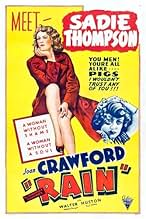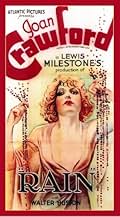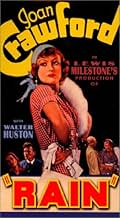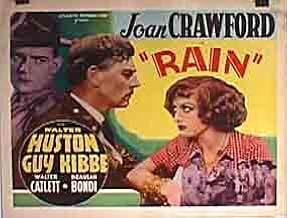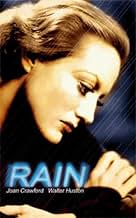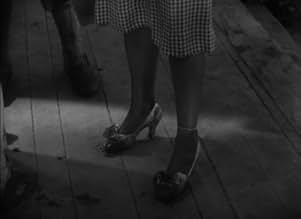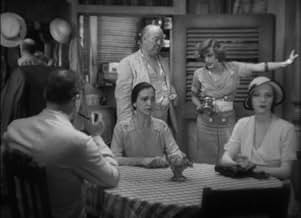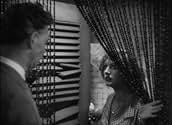VALUTAZIONE IMDb
6,9/10
3287
LA TUA VALUTAZIONE
Una prostituta appena arrivata nel Pacifico meridionale entra in conflitto con un severo missionario determinato a salvare la sua anima.Una prostituta appena arrivata nel Pacifico meridionale entra in conflitto con un severo missionario determinato a salvare la sua anima.Una prostituta appena arrivata nel Pacifico meridionale entra in conflitto con un severo missionario determinato a salvare la sua anima.
- Regia
- Sceneggiatura
- Star
- Premi
- 3 vittorie totali
Fred Howard
- Hodgson
- (as Frederic Howard)
Ben Hendricks Jr.
- Griggs
- (as Ben Hendricks)
Recensioni in evidenza
This story, by Somerset Maugham, has been filmed many times in the last seventy-odd years, but this is the first. I cannot say that it is the best of all possible adaptations; a tacked-on sub-plot (involving a romance with an amorous quartermaster) helps the exposition but dilutes the icy cynicism of the basic story, the missionary and his wife are clumsy caricatures of hellfire and brimstone puritanism, while Joan Crawford's "low-class" accent is more irritating than it is believable -- one is relieved when she forgets to use it. Yet it shines.
The story is told only partially through the script, which seems less wordy than most early talkies: many important points are made purely visually, from the overflowing rainbarrel in the opening sequence to the high-heeled shoe that signals Sadie's return to her prior way of life. The camera *moves*: around tables, in and around groups of people, in and out of doors with incredible smoothness. Crawford's face is also a focus: from her initial "good-time gal" flirting with the sailors to the incredible sequence where she (apparently) converts, she leers, pouts, weeps, and more importantly, knows when to stop, in the three scenes she appears (seemingly) without makeup.
When Rev. Davidson soothes her in her extremis by telling her in a hypnotic voice (backed by native drums) that she is now "radiant, beautiful, one of the daughters of the King" (a moment of sheer unearthly poetry that verges on psychosis), we believe him -- and her. We also believe Huston's face a moment later, as he prays alone, grimaces unreadably, and suddenly resolves into a look of predatory lust just before slipping into her room, the drums implacably beating in the background.
Small excellences abound: the natives are portrayed sympathetically, and for the time, fairly accurately-- I especially liked the use of Polynesian music, which, along with the Sadie's hot jazz records, emphasises the sensual nature of life in the tropics. The subject of her profession is handled tastefully, but frankly and with humor: in referring to a friend's marriage to a sister fille de joie, the quartermaster remarks that they initally met "illegally" and goes on to say that since they met seeing each other at their worst, they can appreciate seeing each other at their best. A running counterpoint is provided by Dr. McPhail, a more-or-less neutral bystander, and Mr. Horne, the genial (and generally supinely drunk) innkeeper, who fusses, chortles, philosophizes, and gets most of the movie's best lines.
Perhaps the best of these occurs sometime after Sadie's conversion: lolling indolently, he reads from a small book something that sounds incredibly like Ecclesiates-- for a moment, we nearly believe that Davidson has converted him, too. Then, finishing the passage, he intones, "Thus spoke Zarathustra.... Good old Nietzche!"
Sixty-five years later, watching the film on a postage-stamp-sized screen of Real Video, I nearly fell out of my chair.
The story is told only partially through the script, which seems less wordy than most early talkies: many important points are made purely visually, from the overflowing rainbarrel in the opening sequence to the high-heeled shoe that signals Sadie's return to her prior way of life. The camera *moves*: around tables, in and around groups of people, in and out of doors with incredible smoothness. Crawford's face is also a focus: from her initial "good-time gal" flirting with the sailors to the incredible sequence where she (apparently) converts, she leers, pouts, weeps, and more importantly, knows when to stop, in the three scenes she appears (seemingly) without makeup.
When Rev. Davidson soothes her in her extremis by telling her in a hypnotic voice (backed by native drums) that she is now "radiant, beautiful, one of the daughters of the King" (a moment of sheer unearthly poetry that verges on psychosis), we believe him -- and her. We also believe Huston's face a moment later, as he prays alone, grimaces unreadably, and suddenly resolves into a look of predatory lust just before slipping into her room, the drums implacably beating in the background.
Small excellences abound: the natives are portrayed sympathetically, and for the time, fairly accurately-- I especially liked the use of Polynesian music, which, along with the Sadie's hot jazz records, emphasises the sensual nature of life in the tropics. The subject of her profession is handled tastefully, but frankly and with humor: in referring to a friend's marriage to a sister fille de joie, the quartermaster remarks that they initally met "illegally" and goes on to say that since they met seeing each other at their worst, they can appreciate seeing each other at their best. A running counterpoint is provided by Dr. McPhail, a more-or-less neutral bystander, and Mr. Horne, the genial (and generally supinely drunk) innkeeper, who fusses, chortles, philosophizes, and gets most of the movie's best lines.
Perhaps the best of these occurs sometime after Sadie's conversion: lolling indolently, he reads from a small book something that sounds incredibly like Ecclesiates-- for a moment, we nearly believe that Davidson has converted him, too. Then, finishing the passage, he intones, "Thus spoke Zarathustra.... Good old Nietzche!"
Sixty-five years later, watching the film on a postage-stamp-sized screen of Real Video, I nearly fell out of my chair.
For reasons that likely have much to do with her self-perceptions, insecurities, and desires for her screen image, Joan Crawford never liked her performance in this fine film. I do not know why; she was never better. The first talkie of the classic Jeanne Eagels' play "Rain", it was effective in every way even though it uses many old-time editing cuts and inserts. They actually worked, and I liked the direction very much, too. Huston was fine as the sanctimonious but sincere preacher trying to convert the "loose woman" Sadie Thompson - but in the end loses the battle, something I wish was shown, but then it wasn't in the play or book so I shouldn't expect it. A fine film, and the antique-type music adds to the effect. See the IMDb review of the serviceble Rita Hayworth version, "Sadie Thompson", and the horrid movie on the life of the actress, "Jeanne Eagels" which contains scenes with Kim Novak trying to recreate the stage play.
Joan Crawford was reportedly not happy with her performance in Rain although for the life of me, I can't figure out what she had to be ashamed about. In a few years Rain could not possibly have been made due to the imposition of The Code where no man of the cloth could be anything less than decent.
Perhaps Crawford was unfortunately compared to Jeanne Eagels on stage and Gloria Swanson in a silent film adaptation which starred Lionel Barrymore as the sex crazed Reverend Davidson. Still Crawford's Sadie Thompson need not take a backseat to anyone else's.
Somerset Maugham wrote the original novel and John Colton adapted it into a play performed on both the London and Broadway stages. Rain is a deceptive work, at first glance it appears quite dated, but in reality its quite relevant for today.
My favorite character in this is Guy Kibbee's Horne who runs the hotel/ trading post on that tropical South Sea Island where all the characters are stranded temporarily. Joan Crawford is there and in the same hotel are the Reverend and Mrs. Davidson played by Walter Huston and Beulah Bondi. Kibbee says he left the USA because he saw that 'reformers' like the Davidsons were beginning to dominate the body politic in America and he wanted out.
Two things made Rain such a big hit at the time both as a book and play. One was Sigmund Freud who was gaining great popularity talking about repressed sexual desires. Freud would have had a field day analyzing both the Davidsons. It's important to remember that Bondi is just as repressed and uptight as Huston. Freud's writings were not just confined to his profession, they were popularly read by the masses.
The second thing was Prohibition. When Kibbee talks about the reformers triumphing (and you have to get the sneer in his voice when he says reformers)he's talking about their greatest triumph, the 18th amendment. The Evangelical Moral Majority types of the day were the ones that brought Prohibition about and America went on its biggest hypocrisy binge because of it. Folks just like the Davidsons inflicted Prohibition and all that went with it on America.
Sadie Thompson represents everything the Davidsons say they despise, but what Reverend Davidson wants. It all leads to tragedy.
What Maugham is saying and being a gay man himself, knew what it was like to be repressed and show a different face publicly, is just live and let live. Such a simple concept, but one some today have a hard time wrapping their minds around.
As for Joan Crawford, she wouldn't have said what she supposedly said about her performance in Rain knowing in the next generation there would be a musical version with a dubbed Rita Hayworth singing with the island kids. Now that one was one for the books.
Perhaps Crawford was unfortunately compared to Jeanne Eagels on stage and Gloria Swanson in a silent film adaptation which starred Lionel Barrymore as the sex crazed Reverend Davidson. Still Crawford's Sadie Thompson need not take a backseat to anyone else's.
Somerset Maugham wrote the original novel and John Colton adapted it into a play performed on both the London and Broadway stages. Rain is a deceptive work, at first glance it appears quite dated, but in reality its quite relevant for today.
My favorite character in this is Guy Kibbee's Horne who runs the hotel/ trading post on that tropical South Sea Island where all the characters are stranded temporarily. Joan Crawford is there and in the same hotel are the Reverend and Mrs. Davidson played by Walter Huston and Beulah Bondi. Kibbee says he left the USA because he saw that 'reformers' like the Davidsons were beginning to dominate the body politic in America and he wanted out.
Two things made Rain such a big hit at the time both as a book and play. One was Sigmund Freud who was gaining great popularity talking about repressed sexual desires. Freud would have had a field day analyzing both the Davidsons. It's important to remember that Bondi is just as repressed and uptight as Huston. Freud's writings were not just confined to his profession, they were popularly read by the masses.
The second thing was Prohibition. When Kibbee talks about the reformers triumphing (and you have to get the sneer in his voice when he says reformers)he's talking about their greatest triumph, the 18th amendment. The Evangelical Moral Majority types of the day were the ones that brought Prohibition about and America went on its biggest hypocrisy binge because of it. Folks just like the Davidsons inflicted Prohibition and all that went with it on America.
Sadie Thompson represents everything the Davidsons say they despise, but what Reverend Davidson wants. It all leads to tragedy.
What Maugham is saying and being a gay man himself, knew what it was like to be repressed and show a different face publicly, is just live and let live. Such a simple concept, but one some today have a hard time wrapping their minds around.
As for Joan Crawford, she wouldn't have said what she supposedly said about her performance in Rain knowing in the next generation there would be a musical version with a dubbed Rita Hayworth singing with the island kids. Now that one was one for the books.
RAIN (United Artists, 1932), directed by Lewis Milestone, from the short story about sex, sin and salvation by W. Somerset Maugham, stars Miss Joan Crawford (courtesy of the Metro-Goldwyn-Mayer Company), in one of her most prestigious movie roles that stands in a class by itself. Originating as a 1922 stage play starring Broadway's legendary Jeanne Eagles, it first appeared on screen during the silent era as SADIE THOMPSON (United Artists, 1928), starring Gloria Swanson and Lionel Barrymore. Regardless of its then controversial subject matter, it did well at the box office, earning Swanson an Academy Award nomination. Four years later, it was remade as RAIN. Considering what might have been logical choice in having Swanson and Barrymore reprising their original roles with spoken dialog in place of title cards, Crawford and Walter Huston, forceful screen personalities, were fine substitutes. Unfortunately, lightning or heavy rains didn't strike twice, for that Crawford's sound adaptation reportedly became a box-office flop. The fault might have been for its bad timing, remaking a film so close to its original, and Jeanne Eagles still being in the memory of those who have witnessed her performance on stage, yet had RAIN been distributed a few years later, it might have met with problems with the censors and production code, thus, not having that spark of solid dialog that this version has, and yet, probably would not have had that "filmed stage play" appearance either. The camera does take time out for some location viewing of the Cataline Islands, where portions of the film were reportedly lensed.
For the benefit of those who are totally unfamiliar with the Maugham story and/or the movie itself, the plot is set in Pago Pago, the Samoan island where a group of steamer passengers are forced to remain because of a minor epidemic on board. And due to the heavy rains, they find they must stay a little longer than anticipated. Among the passengers entering the island's general store/hotel run by Joe Horn (Guy Kibbee) and his native wife (Mary Shaw) are Doctor Robert MacPhail (Matt Moore), a philosopher, and wife, Nina (Kendall Lee); Alfred and Martha Davidson (Walter Huston and Beulah Bondi), a missionary couple, among others. Entertaining the Marines in her state room is Miss Sadie Thompson (Joan Crawford), a prostitute, who enjoys the company of men, playing loud jazzy music and cigarette smoking. She quickly catches the eye of Sergeant Tim O'Hara (William Gargan) but the disapproval of Davidson, who objects to her immoral ways such as drinking and smoking on the Sabbath. At first Davidson forces himself upon her to reform. All he finds is that his religious persistence annoys her and that Sadie can be equally demanding and powerful as he. Sadie tries to meet him half way when she learns that she must return to San Francisco and serve a three year prison sentence, and becomes bitter when Davidson won't give in to her pleas. Eventually Davidson does succeed in saving Sadie's immortal soul by cleansing her from her sins, but in turn, Davidson soon finds himself being lead into temptation and unable to be delivered from evil.
For many years, RAIN has earned the reputation as being one of Crawford's mistakes. On the contrary, it's Crawford's performance that keeps the story together. For the first hour, she appears with cat eyes, heavy makeup, curly hair, cigarette, birth mark under the left side of her chin and wearing a tight checkered dress. Her transformation scene occurring later having Crawford's Sadie cleansed from her sins and appearing pure at heart, is surprisingly effective. Walter Huston almost upstages Crawford every which way he can. He, too, gives a solid performance as the Reverend Davidson. The famous scene where Davidson recites the Lord's prayer with the swearing Sadie suddenly reciting the prayer with him, is one of the film's true memorable moments. This scene itself became a clip used for the mid 1970s TV show, "Don Adams Screen Test," for young hopefuls to re-enact this particular scene and win a trip to Hollywood and a part in an upcoming TV show or motion picture. Up to then, RAIN was winning a new audience.
Director Milestone was given a difficult task in keeping the pace moving by circling the camera around, moving it at all different angles so not to focus on the central characters for any length of time. His directing technique might not meet with much appreciation today, but his overlooked method as to how to develop the story and characters on a set stage are evident here. Along with forceful dialog, Milestone full takes advantage of this new medium of sound with the use of repeated rain heard falling on the ground and rooftops. The Alfred Newman underscoring benefits the film as well.
I first came across RAIN when it made a special television presentation on WNEW, Channel 5, in New York City, June 10, 1973. Preceding the movie was a surprise presentation by Joan Crawford herself giving her profile about working in RAIN. Initially released at 93 minutes, a 77 minute print was presented during its 90 minute time slot with commercial interruptions. By the 1980s, however, RAIN became one of many public domain titles distributed to home video, mostly in full length. Cable television presentations shortly afterwards, ranging from Arts and Entertainment and the Learning Channel (1980s), American Movie Classics (1991-2000) and Turner Classic Movies (TCM premiere March 8, 2007).
Columbia updated the Maugham story to post World War I as MISS SADIE THOMPSON (1953) starring Rita Hayworth and Jose Ferrer, with the addition of Technicolor and songs. Of the three screen incarnations of Sadie Thompson vs. The Reverend Davidson (The Prostitute and the Reformer), RAIN (1932) is the best known and revived, especially on rainy day. Although the film itself has aged, the story itself hasn't. (**1/2)
For the benefit of those who are totally unfamiliar with the Maugham story and/or the movie itself, the plot is set in Pago Pago, the Samoan island where a group of steamer passengers are forced to remain because of a minor epidemic on board. And due to the heavy rains, they find they must stay a little longer than anticipated. Among the passengers entering the island's general store/hotel run by Joe Horn (Guy Kibbee) and his native wife (Mary Shaw) are Doctor Robert MacPhail (Matt Moore), a philosopher, and wife, Nina (Kendall Lee); Alfred and Martha Davidson (Walter Huston and Beulah Bondi), a missionary couple, among others. Entertaining the Marines in her state room is Miss Sadie Thompson (Joan Crawford), a prostitute, who enjoys the company of men, playing loud jazzy music and cigarette smoking. She quickly catches the eye of Sergeant Tim O'Hara (William Gargan) but the disapproval of Davidson, who objects to her immoral ways such as drinking and smoking on the Sabbath. At first Davidson forces himself upon her to reform. All he finds is that his religious persistence annoys her and that Sadie can be equally demanding and powerful as he. Sadie tries to meet him half way when she learns that she must return to San Francisco and serve a three year prison sentence, and becomes bitter when Davidson won't give in to her pleas. Eventually Davidson does succeed in saving Sadie's immortal soul by cleansing her from her sins, but in turn, Davidson soon finds himself being lead into temptation and unable to be delivered from evil.
For many years, RAIN has earned the reputation as being one of Crawford's mistakes. On the contrary, it's Crawford's performance that keeps the story together. For the first hour, she appears with cat eyes, heavy makeup, curly hair, cigarette, birth mark under the left side of her chin and wearing a tight checkered dress. Her transformation scene occurring later having Crawford's Sadie cleansed from her sins and appearing pure at heart, is surprisingly effective. Walter Huston almost upstages Crawford every which way he can. He, too, gives a solid performance as the Reverend Davidson. The famous scene where Davidson recites the Lord's prayer with the swearing Sadie suddenly reciting the prayer with him, is one of the film's true memorable moments. This scene itself became a clip used for the mid 1970s TV show, "Don Adams Screen Test," for young hopefuls to re-enact this particular scene and win a trip to Hollywood and a part in an upcoming TV show or motion picture. Up to then, RAIN was winning a new audience.
Director Milestone was given a difficult task in keeping the pace moving by circling the camera around, moving it at all different angles so not to focus on the central characters for any length of time. His directing technique might not meet with much appreciation today, but his overlooked method as to how to develop the story and characters on a set stage are evident here. Along with forceful dialog, Milestone full takes advantage of this new medium of sound with the use of repeated rain heard falling on the ground and rooftops. The Alfred Newman underscoring benefits the film as well.
I first came across RAIN when it made a special television presentation on WNEW, Channel 5, in New York City, June 10, 1973. Preceding the movie was a surprise presentation by Joan Crawford herself giving her profile about working in RAIN. Initially released at 93 minutes, a 77 minute print was presented during its 90 minute time slot with commercial interruptions. By the 1980s, however, RAIN became one of many public domain titles distributed to home video, mostly in full length. Cable television presentations shortly afterwards, ranging from Arts and Entertainment and the Learning Channel (1980s), American Movie Classics (1991-2000) and Turner Classic Movies (TCM premiere March 8, 2007).
Columbia updated the Maugham story to post World War I as MISS SADIE THOMPSON (1953) starring Rita Hayworth and Jose Ferrer, with the addition of Technicolor and songs. Of the three screen incarnations of Sadie Thompson vs. The Reverend Davidson (The Prostitute and the Reformer), RAIN (1932) is the best known and revived, especially on rainy day. Although the film itself has aged, the story itself hasn't. (**1/2)
Interesting well-directed adaptation of Somerset Maugham story about a prostitute and a missionary out to reform her. I was surprised to discover this was a box office flop when it was released as I enjoyed it very much. Joan Crawford and Walter Huston are great as the two leads. Beulah Bondi and Guy Kibbee offer solid support. But the real star is Lewis Milestone's wonderful direction. He takes what would otherwise have been a very stagey film, especially for 1932, and keeps the camera moving and lively. Milestone not only directed but produced Rain as well. He was one of the best directors of the 1930s and I don't feel like he gets anywhere near enough credit. Try to catch this if you can but beware of bad prints.
Lo sapevi?
- QuizCostumer Milo Anderson bought Joan Crawford's checkered dress at a department store and later recalled that the dress required extensive alteration, being far too large for Crawford everywhere except in the shoulders. Still new to the business, Anderson did not realize that multiple copies would be needed of a costume worn so extensively throughout the film. When it came time for a second copy, Anderson discovered that the dress had sold out and was now not available anywhere. Nor could the checkered fabric be located. Since the dress had already been seen in numerous scenes, the only solution was to have the design laboriously painted onto cloth and then have the dress duplicated. The dress had originally been store-bought to save money--and ultimately, with all the work, it added considerably to the film's budget.
- BlooperAt the beginning, where the ship's passengers are handing over their passports and shore passes to be checked, the serial number on all the passes is the same.
- Citazioni
Sadie Thompson: You men! PIGS!
- ConnessioniEdited into Haunted Hollywood: Rain (2016)
- Colonne sonoreSt. Louis Blues
(1914) (uncredited)
Written by W.C. Handy
Played during the opening credits and often in the score
I più visti
Accedi per valutare e creare un elenco di titoli salvati per ottenere consigli personalizzati
Dettagli
Botteghino
- Lordo Stati Uniti e Canada
- 1.172.840 USD
- Lordo in tutto il mondo
- 1.534.720 USD
- Tempo di esecuzione1 ora 34 minuti
- Colore
- Proporzioni
- 1.37 : 1
Contribuisci a questa pagina
Suggerisci una modifica o aggiungi i contenuti mancanti


